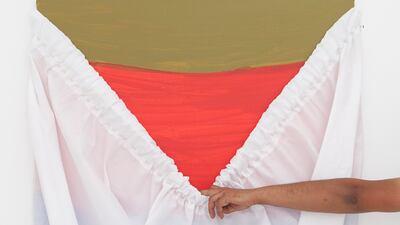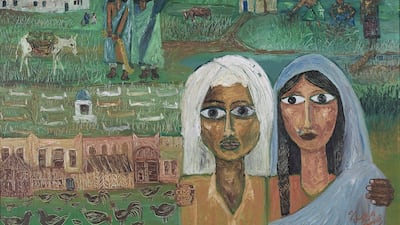The artists who will present works at NYU Abu Dhabi Art Gallery's landmark autumn exhibition have been announced.
Titled Khaleej Modern: Pioneers and Collectives in the Arabian Peninsula, 1941-2008, the show, which will open on September 6, seeks to document 20th-century modern art movements in the Gulf.
It's being curated by Aisha Stoby, who this year also curated the inaugural Oman Pavilion at the Venice Biennale, as it’s based on Stoby’s doctorate research tracing the region's “pre-boom era”.
The historical survey examines the evolution of visual art movements across the region as it transformed after the discovery of oil.
“An exhibition like this is quite rare, a kind of opening salvo and call to action, offering new vistas on art history and art practice in this region," Maya Allison, executive director of the NYU Abu Dhabi Art Gallery and university chief curator, said.
Allison also describes it as a "crucial, path-breaking project".
"Rather than a definitive survey, this project sets us on a journey to explore the understudied — and, for some people, unknown — emergence of modern art in the Arabian Peninsula over the last century. It is a profound honour that Dr Stoby will present her original research with us, in this exhibition that was many years in the making."
Local art histories will be contextualised by tradition, modernisation and evolving national identities. Artistic pioneers and collectives from the 20th and 21st centuries will be studied, beginning with the first exhibition of Kuwait's Al Mubarakiya School in 1941.
Saudi Arabia’s modern art scene dates back as early as 1938, and to explore this, works will be included by artists such as Mounirah Mosly, Safeya Binzagr, Abdulhalim Radwi and Abdullah Al Shaikh. Pieces by Mohammed Al Saleem and Abdulrahman AlSoliman are also being provided by the Saudi House of Fine Arts in Riyadh.
For Bahrain, Stoby takes us back to the 1950s, when the Manama Group formed, with Abdul Karim Al-Orrayed, Nasser Al Yousif and Ahmed Qassim Al Sunni.
Over the following 20 years, The Three Friends collective was active in Qatar, comprising Yousef Ahmed, Hassan Al Mulla and Mohammed Ali Abdullah.
In the UAE, early art practitioners whose work will be touched on in the survey include Abdul Qader Al Rais and The Group of Five, comprising Hassan Sharif, Abdullah Al Saadi, Mohammed Kazem, Mohamed Ahmed Ibrahim and Ebtisam Abdulaziz.
Scroll through the below to see images from Mohamed Ahmed Ibrahim's latest Dubai exhibition Embryonic Coat
Important figures from Oman will also be included, such as Anwar Sonya, Rabha Mahmoud and the The Circle group, led by Hassan Meer.
It is the first time work by these trailblazing artists will be brought together, and many of the pieces will be on view for the first time in decades, said Stoby.
"Enhanced by the presence of rare and archival material, Khaleej Modern creates a space and offers resources for learning and re-understanding our own histories,” she said. "More broadly, we hope the exhibition will contribute to wider regional and global understandings of modern visual art.
"This project responds to emerging debates around recentring art narratives, toward a more nuanced and inclusive appreciation of global art histories.”
Khaleej Modern: Pioneers and Collectives in the Arabian Peninsula, 1941-2008 will run at NYUAD Art Gallery from September 6 to December 11
Episode list:
Ep1: A recovery like no other- the unevenness of the economic recovery
Ep2: PCR and jobs - the future of work - new trends and challenges
Ep3: The recovery and global trade disruptions - globalisation post-pandemic
Ep4: Inflation- services and goods - debt risks
Ep5: Travel and tourism
One in nine do not have enough to eat
Created in 1961, the World Food Programme is pledged to fight hunger worldwide as well as providing emergency food assistance in a crisis.
One of the organisation’s goals is the Zero Hunger Pledge, adopted by the international community in 2015 as one of the 17 Sustainable Goals for Sustainable Development, to end world hunger by 2030.
The WFP, a branch of the United Nations, is funded by voluntary donations from governments, businesses and private donations.
Almost two thirds of its operations currently take place in conflict zones, where it is calculated that people are more than three times likely to suffer from malnutrition than in peaceful countries.
It is currently estimated that one in nine people globally do not have enough to eat.
On any one day, the WFP estimates that it has 5,000 lorries, 20 ships and 70 aircraft on the move.
Outside emergencies, the WFP provides school meals to up to 25 million children in 63 countries, while working with communities to improve nutrition. Where possible, it buys supplies from developing countries to cut down transport cost and boost local economies.
MEYDAN CARD
6.30pm Maiden Dh165,000 (Dirt) 1,600m
7.05pm Conditions Dh240,000 (D) 1,600m
7.40pm Handicap Dh190,000 (D) 2,000m
8.15pm Handicap Dh170,000 (D) 2,200m
8.50pm The Entisar Listed Dh265,000 (D) 2,000m
9.25pm The Garhoud Sprint Listed Dh265,000 (D) 1,200m
10pm Handicap Dh185,000 (D) 1,400m
The National selections
6.30pm Majestic Thunder
7.05pm Commanding
7.40pm Mark Of Approval
8.15pm Mulfit
8.50pm Gronkowski
9.25pm Walking Thunder
10pm Midnight Sands
Indoor Cricket World Cup
Venue Insportz, Dubai, September 16-23
UAE squad Saqib Nazir (captain), Aaqib Malik, Fahad Al Hashmi, Isuru Umesh, Nadir Hussain, Sachin Talwar, Nashwan Nasir, Prashath Kumara, Ramveer Rai, Sameer Nayyak, Umar Shah, Vikrant Shetty
What are NFTs?
Are non-fungible tokens a currency, asset, or a licensing instrument? Arnab Das, global market strategist EMEA at Invesco, says they are mix of all of three.
You can buy, hold and use NFTs just like US dollars and Bitcoins. “They can appreciate in value and even produce cash flows.”
However, while money is fungible, NFTs are not. “One Bitcoin, dollar, euro or dirham is largely indistinguishable from the next. Nothing ties a dollar bill to a particular owner, for example. Nor does it tie you to to any goods, services or assets you bought with that currency. In contrast, NFTs confer specific ownership,” Mr Das says.
This makes NFTs closer to a piece of intellectual property such as a work of art or licence, as you can claim royalties or profit by exchanging it at a higher value later, Mr Das says. “They could provide a sustainable income stream.”
This income will depend on future demand and use, which makes NFTs difficult to value. “However, there is a credible use case for many forms of intellectual property, notably art, songs, videos,” Mr Das says.
RESULT
Kolkata Knight Riders 169-7 (20 ovs)
Rajasthan Royals 144-4 (20 ovs)
Kolkata win by 25 runs
Next match
Sunrisers Hyderabad v Kolkata Knight Riders, Friday, 5.30pm
The specs
Engine: 1.5-litre turbo
Power: 181hp
Torque: 230Nm
Transmission: 6-speed automatic
Starting price: Dh79,000
On sale: Now
What can victims do?
Always use only regulated platforms
Stop all transactions and communication on suspicion
Save all evidence (screenshots, chat logs, transaction IDs)
Report to local authorities
Warn others to prevent further harm
Courtesy: Crystal Intelligence




































